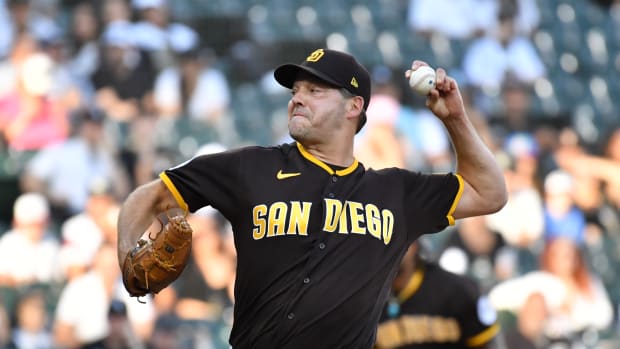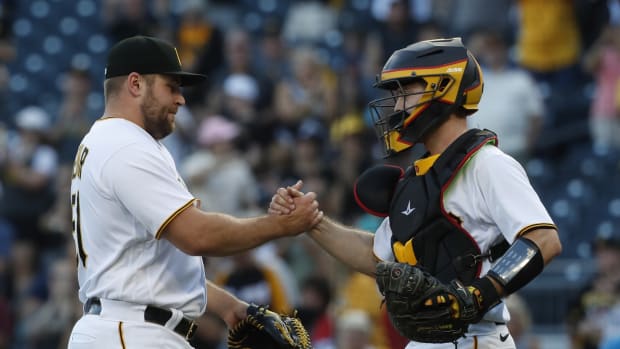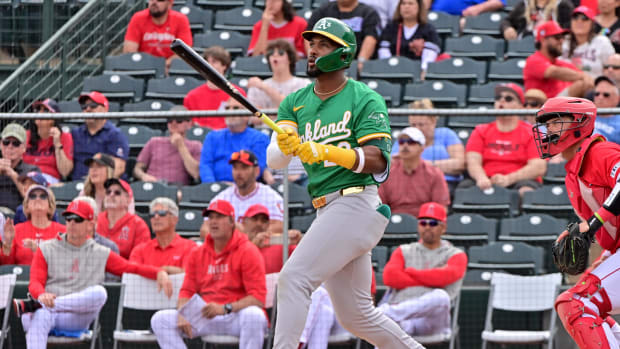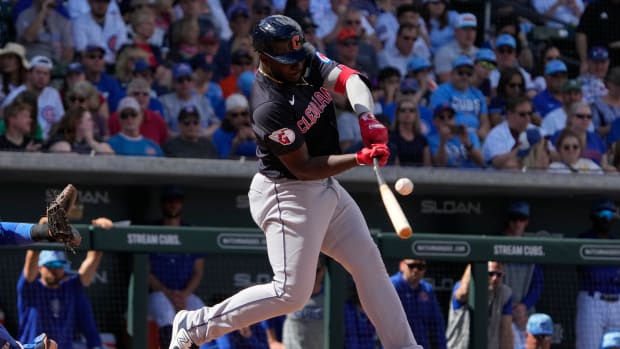Time has come to make runners plowing over catchers illegal
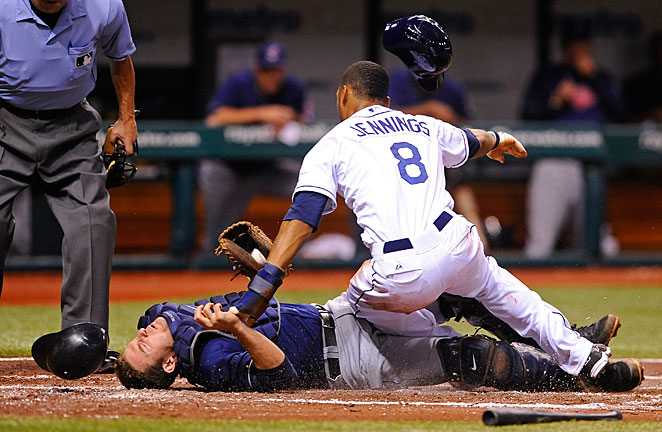
Cleveland catcher Lou Marson was fortunate to avoid serious injury when the Rays' Desmond Jennings ran him over last Saturday.
/AP
I have seen enough, and I don't need for Lou Marson to wind up in a hospital to know this must stop.
Marson is lucky, and the rest of baseball is stone silent today rather than outraged or deeply reflective simply because of Marson's dumb luck. Marson is the Cleveland Indians catcher who Saturday happened to be holding a baseball, stock still, as Desmond Jennings of the Tampa Bay Rays, after gathering about 80 feet of full-speed energy, plowed into him -- his tucked shoulder smashing into Marson's helmet -- on what otherwise was an obvious out play at home plate.
The jolt knocked the helmet and mask from Marson's head. He lurched backward and fell. Marson's unprotected head slammed against the ground. (He held on to the ball for the out.) Incredibly, after a brief examination by medical professionals, the Indians allowed Marson to stay in the game. They removed him the next inning, announcing that he suffered only a strained neck. (UPDATE: On Tuesday afternoon, the Indians put Marson on the 15-day disabled list with a neck strain.)
It could have been far worse. Nothing but incredible luck stood between Marson and being the next poster catcher for a national debate about the most reckless, unnecessary play in baseball.
What Jennings did was unquestionably a "clean play." He tried to score on a bouncer to third base, saw the throw take Marson into the baseline and, instead of avoiding him, used his body as a weapon. An old school aficionado would even applaud it as "hard-nosed" baseball. Marson quickly was praised for being "tough," and "a football player." Such macho nonsense would not have gone over so well had Marson wound up in the hospital with his leg mangled, as Buster Posey did two years ago, or had his career ruined, as happened for Ray Fosse, Bobby Wilson, Brett Hayes and the legion of other catchers who were never the same after getting smashed by a runner at home plate.
GALLERY: 50 memorable home plate collisions
Is that what it will take? Will it take another gruesome injury or a career ruined to stop allowing runners to plow into catchers? It is the dumbest rule in baseball -- or, more accurately, the dumbest oversight in baseball. We let runners use their bodies as missiles nowhere else on a baseball field, but they can do so against defenseless catchers. Why?
This is the best rationale people come up with when they try to defend the legal violence at home plate: "It's part of the game."
Well, it was once "part of the game" to throw the baseball at a runner to put him out. It was once "part of the game" to wear only a ballcap in the batter's box against pitchers who regularly threw at your head. It was once "part of the game" to have no padding on the outfield walls. It was once "part of the game" to have no protective netting in front of dugouts. It was once "part of the game" to sharpen your spikes and leap into infielders on the basepaths with the intent of cutting them open. It was once "part of the game" to throw a rolling body block on a second baseman trying to make a double play pivot.
We are smarter and the game is better for removing such behavior as "part of the game."
Imagine you were inventing baseball today. Everybody agrees that you should not be allowed to simply plow into a fielder with the ball at first base, second base and third base. So what fool would decide not to give the catcher such obvious protection? Please don't say the catcher is wearing equipment; it is designed to protect a catcher from pitched and fouled balls, not a 220-pound man running at full speed the length of a city block. And if you say, "that's the way it's always been done," that's not good enough. Tradition should not trump stupidity.
"I don't see the sense of it," Cardinals manager Mike Matheny said this spring.
Matheny is a former catcher and a former "part of the game" old-school adherent who grew to assume that catchers had to be tough and to take punishment dished out by runners. He also saw his career ended by too many concussions. As a manager watching catchers constantly put in harm's way unnecessarily, he has since changed his mind and now sees the stupidity in allowing collisions.
"I do believe that this game will get to the point where there will no longer be a collision at the plate," he said in strong comments that deserved even greater attention at the time. "And I am 100 percent in support of that."
Matheny's words, especially given the reversal of his position, will be an important catalyst for change. The conversation began in earnest when Posey, a young star, suffered a broken leg and torn ligaments in his 2011 collision with Scott Cousins of the Marlins. Now, sadly, it appears the real tipping point to that conversation will have to be another serious injury.
Why? Why are we waiting for another young man to suffer great harm? One of the reasons for the inaction is that some of the closest advisors to commissioner Bud Selig are old-school types who grew up with the macho code: vice president Joe Torre and managers Jim Leyland and Mike Scioscia, all of whom sit on Selig's on-field advisory committee.
When Posey's manager in San Francisco, former catcher Bruce Bochy, lobbied publicly for a no-collision rule, Torre said he was in favor of making the game safer as long as it did not "affect the way the game is played." Nothing he heard, he said, was enough to provoke a rules change, though he would continue to listen.
Leyland told reporters he did not want to take away the catcher's right to block the plate. He added that asking runners to avoid a collision could actually cause injury to the runner -- "turn an ankle or something." (Incredibly, as catchers continue to get wiped out with serious injuries, Indians manager Terry Francona agreed about a no-collision rule putting the runner at risk, saying before the Marson hit, "You're going to get more base runners injured. The game is going too fast. You've just got to let guys play.")
Scioscia decided that adopting a no-collision rule is "a tough thing to legislate" -- even though the NCAA does a fine job of it: a runner has to make an attempt to score, not to attempt to separate the baseball from the catcher - and "contact above the waist that was initiated by the runner" is not considered an attempt to score.
See, every level of baseball except professional -- youth, high school, college -- has a no-collision rule and the game is just fine without collisions. More importantly, the catchers are out of harm's way. It's not "tough to legislate" at all.
Players make a lot of money, but this is not about "protecting investments" or "with all the money at stake today . . ." It's not about taking a cue from the NFL, which, in the face of lawsuits, particularly as they relate to concussions, is re-writing its rules and changing the way the game is played in the spirit of player safety. It's about common sense. If it makes sense for a high school or college kid who is making no money, why should safety be any less important for a professional?
The home plate collision is part of the game's lore, and baseball too often lets history become bigger than what's logical. (See, instant replay.) The quintessential Pete Rose moment is Rose running over Ray Fosse in the 1970 All-Star Game, breaking Fosse's shoulder and essentially ruining his career. Rose was celebrated for it. You had J.T. Snow plowing into Ivan Rodriguez for the last out of the 2003 NLDS. And how is this good for anything but our prurient interest in violence?
Check out The Strike Zone, SI.com's new baseball blog
Treat home plate as you would any other base. If the ball beats you on the bases, you can't just blow up an infielder. In 1996 Albert Belle was fined and vilified for crashing into Brewers second baseman Fernando Viña in the basepath between first and second -- behavior that is tame compared to what goes on legally at home plate.
Before there was Rose, there was Ty Cobb. In his biography, My Life in Baseball, Cobb wrote, "When I began playing the game baseball was as gentlemanly as a kick in the crotch."
In 1948 Cobb said, "The base paths belong to the runner . . . I had sharp spikes on my shoes. If the baseman stood where he had no business to be and got hurt, it was his fault."
In 1961 Cobb, unconvincingly given his reputation, admitted to intentionally trying to spike only two players: a catcher, Harry Bemis, "who roughed me up when I slid into home," and a pitcher, Hub Leonard, who "would aim bullets at your head." Cobb once dragged a bunt against Leonard, intentionally drawing the pitcher into his path. When Leonard continued into the first-base coaching box, Cobb followed him there and dove feetfirst at him with his sharpened spikes.
Trying to spike a pitcher in the coaching box sounds downright barbaric to anyone with today's sensibilities. Hopefully, there will come a day, and soon, when we look back when we allowed runners to batter defenseless catchers as an act of equal stupidity and senselessness. The fear is that more catchers, far less fortunate than Marson, will have their careers altered before baseball does anything about this dangerous "part of the game."































